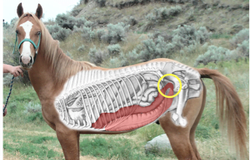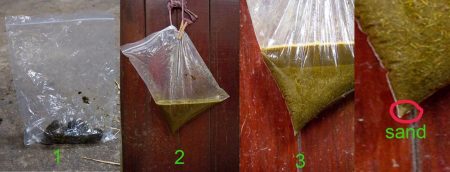Previously, we have discussed small intestinal colic and gastric ulcers. However, when discussing colic, we have to determine if it is small intestinal in origin or large intestinal.
Below is a brief list of problems associated with the large colon. Typically, these are non-surgical and can be resolved with some medical management. That’s not ALWAYS the case, but for the most part it is. (Part 2 will focus on more severe types of large intestinal colic.)
The large intestine begins as the ileum (the last section of the small intestine) enters the cecum and is approximately 40 feet long. The cecum is a blind sac that is shaped like a “C” and is a big fermentation vat. The curvaceous colon then takes a bunch of twists and turns after it exits the cecum. First, it becomes the right ventral colon. It changes into the left ventral colon and takes a big, narrow turn (the pelvic flexure) into the left dorsal colon. It then turns again to become the right dorsal colon. But we’re not done yet! From here, the intestine narrows into the small colon and finally the rectum, which is the last foot or so of the colon. Whew! With all of that crammed into a space about the size of a 33 gallon trash can (along with all the other organs!), what could possibly go wrong? Let’s find out!
Gas/Spasmodic Colic: With all of the fermentation that goes on within the large intestine, a lot of gas is produced. Occasionally, the colon can become a little distended and uncomfortable. These will often correct themselves with a little bit of time and maybe some pain meds. Please remember to contact your veterinarian and discuss this with them, as it could be something more serious. Sometimes, simply walking horses for a bit can help things move along and uh, expel the gases. Just remember, we want to walk them for a bit then let them rest. Walking non-stop does nothing more than exhaust yourself and your horse.

Impactions: Another common finding are pelvic flexure impactions. These occur because this is an area of the LI that narrows significantly. When horses become a little dehydrated, the feed material binds together more easily and gets stuck. We find these happen more frequently during cold weather as horses tend to drink less.
Other types of impactions include cecal impactions, where a large amount of feed material becomes trapped within the cecum, and small colon impactions, which tend to be more common in miniature horses. These can be more difficult to treat, but still follow the same pattern as pelvic flexure impactions.
The mainstay of treatment for any of these is fluids, fluids, and more fluids. Absolutely no food should be given to horses with an impaction (or any colic for that matter), as it will continue to build up and make the impaction harder to move. Many times we can pass a tube and administer oral fluids to get everything moistened up and moving again. Other times, we may need to re-hydrate the patient with a combination of IV and oral fluids. Occasionally, these can become severe enough to require surgery.
Sand Colic: Sand colic occurs when horses are fed on sandy ground. As they eat their hay, they also take in sand particles. This sand then sediments out in the ventral colon and sits there. While laying against the wall of the intestine, it can cause severe irritation and lead to diarrhea. The more that builds, the more uncomfortable they can become. The sand can even become impacted, which may require surgery. The best bet for these is prevention, by either feeding in a hay feeder or placing a rubber mat over sandy ground and feeding on that.
If you’re not sure if your horse has ingested sand, here’s a simple way to find out! Grab a couple of fecal balls (make sure there’s no obvious sand stuck to them) and put them in a ziploc bag. Add water and mash up the fecal balls. Then hang the bag on an angle, so one corner points down. After 5-10 minutes, come back and check it. The sand, if present, will sediment into the corner of the bag. Sometimes you can see a thin layer of it, other times you nee to squeeze the corner between your fingers and feel the gritty texture. If you notice any, you may want to consult your vet for treatment options and consider changing where/how you feed.

As already mentioned, if you think your horse is colicking, all food should be pulled. We don’t want to make a bad situation worse. Horses can be off feed for quite a long time with few ill effects. The next thing to do is contact your veterinarian. We don’t recommend administering medications prior to calling. This is because if we do need to come out, medications can mask signs that might help with a diagnosis.
Stay tuned for Part 2 where we’ll discuss more serious and surgical types of large intestinal colic.


